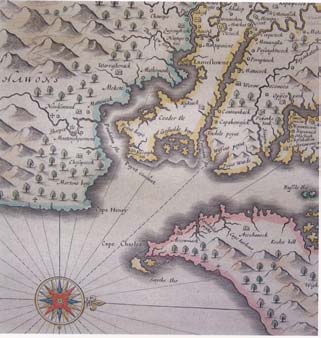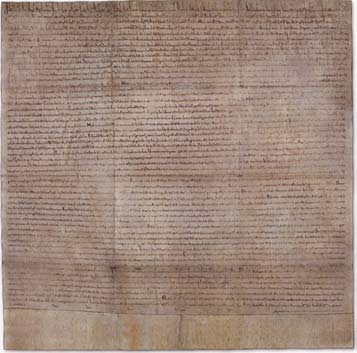Magna Carta at
The Contemporary Art Center of Virginia
March 29 – June 18, 2007
When the English settlers made landfall in Virginia Beach in 1607, they had little in the way of manpower, supplies, or knowledge of the new world. What they did have was a set of ideals and principles they intended to bring to their new colony. Those principles were drawn directly from Magna Carta, a document issued by the King of England in the dark of medieval Britain in 1215 and the first official expression of “The Rights of Man.” While the tenets of Magna Carta blossomed into new nations, social philosophies, and cultural democracies, the Magna Carta calfskins themselves were gradually lost to the ravages of time. Today, only four of the original 1215 Magna Carta documents remain.
Working closely with Lincoln Cathedral in Lincolnshire, England, the Contemporary Art Center of Virginia is preparing for one of the very special events in recent memory in Virginia. In celebration of First Landing in April 1607, CAC will exhibit the Lincoln Cathedral Magna Carta, the founding document of free democracy and the American legal and governmental system that underpins it.


2200 Parks Avenue, Virginia Beach, VA 23451 • 757-425-0000 • Fax 757-425-8186 • www.cacv.org
Background
Nulli vendemus, nulli negaimus aut differemus recturm aut justiciam -- To no one will we sell, to no one will we deny or delay right or justice
In June of 1215, English barons rose up and forced the King John to ride out upon the fields of Runnymede and sign the “big charter,” Magna Carta. In that moment, the energy of liberty was forever unleashed upon the world.
Magna Carta became the foundation of law that would entitle a person to a trial by his or her peers, establish taxation through representation, allow women the right to own property, call for the separation of church and state, and allow for the expression of the will of the people through a democratic system.
In Magna Carta appear references to the rights of life, liberty, and property, concepts that resurfaced centuries later across an ocean when Thomas Jefferson wrote the Declaration of a new nation. The Bill of Rights, the U.N. Declaration of Human Rights, central elements of modern law in the United States and Britain, and numerous constitutional documents in democracies around the world all directly trace their roots to Magna Carta.
Now, planning is underway for Magna Carta to visit the United States in association with the quadricentennial of First Landing of the English settlers. The exhibit of the document and educational programs will trace the roots of democracy to today’s American principles and values. Most importantly, the exhibit will recognize and honor the countless ways in which citizens act every day to breathe continual life into the principles of liberty.
Partnership with Lincoln Cathedral
Scholars believe approximately thirty exemplifications of Magna Carta were made for distribution to the counties of the kingdom in 1215. Today, only four remain: one at Salisbury Cathedral, two in the British Library, and the fourth, said to be the finest, at the Lincoln Cathedral in England. It is the Lincoln Cathedral copy that will travel to the Contemporary Art Center of Virginia under special permission from the British government.
The Dean of Lincoln Cathedral, Dr. Alex Knight, and the Chief Executive, Roy Bentham, are overseeing all permissions for use and arrangements for the exhibit. The Contemporary Art Center of Virginia and the City of Virginia Beach are working closely with Lincoln Cathedral to develop the exhibition.
Magna Carta exhibit
The Magna Carta exhibit, designed by an award-winning Virginia firm working with CAC, will reflect the thoughts and actions that created our concepts of liberty. CAC’s highly regarded educators are participating in the interpretation and development of exhibits that express how Magna Carta is as relevant today as it was eight hundred years ago.
Alongside the document, interactive touch-screens will include content from leading scholars, historians, and authors. In adjacent galleries, CAC will present a new art exhibition titled By Our Heirs Forever: Magna Carta in the 21st Century that will ask over sixty leading contemporary artists across Virginia to create works in response to the tenets of Magna Carta.
Apart from Magna Carta itself, plans include the Charter of King John, significant artifacts relating to Virginia, and the Charter of the Forest. In addition, efforts are underway to secure loans of early broadsides of the Declaration of Independence and the Emancipation Proclamation. Lincoln Cathedral’s Christopher Wren Library will lend extremely rare books from its collection.
The Magna Carta exhibit will reflect the progression of our democracy in the United States and the contributions made by people of diverse backgrounds and views. CAC’s goal is for visitors to the exhibit to be able to connect Magna Carta to the events and dialogue of today.
Message
Magna Carta will be the touchstone for the exhibit and will convey the significance of each person’s engagement in a dynamic democracy. The enduring themes of Magna Carta that underpin our concepts of democracy include:
- Just power is derived from the governed;
- Inalienable rights are at the core of democracy; and
- Liberty is a shared value in the evolution of democracy.
CAC will underscore that these are not static, dusty ideas in history books, but ones that permeate countless decisions of our daily lives. Visitors will learn that the rights of man, civil liberties, human rights, and other contemporary topics are all part of the Magna Carta story. Magna Carta will invite the visitor to recognize that he or she, too, is indispensable in the daily enterprise of democracy.
National Education Association
CAC believes it is essential to involve Virginia’s educators deeply in planning, outreach, and community engagement with the Magna Carta exhibition. Accordingly, the National Education Association has joined the project as a major sponsor.
NEA has pledged to leverage its enormous reach in support of the exhibit. With 2.7 million members in every community in the country – and the millions of students they teach – NEA will play a leading role in advancing the educational mission of the exhibit.
Furthermore, NEA celebrates its 150th anniversary in the summer of 2007 in Philadelphia. NEA will draw upon the exhibit as an element in its celebrations in Philadelphia.